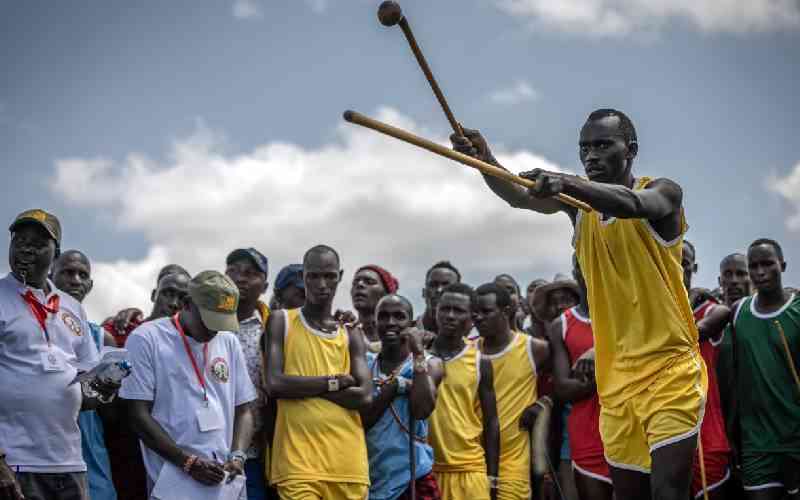By ISAIAH LUCHELI
Little known Lake Chamness in Kajiado County has been a source of livelihood for Maasai pastoralists.
The man-made lake constructed by a missionary in Oloshibor in Kajiado North in 1972, which has also acted as a source of water for irrigation and livestock, is in danger of drying up, which could spell doom for the many families.
Torrential rains that pounded the area last year destroyed the lake and siltation occasioned by erosion has led to the reduction of water level.
The heavy rains also destroyed pipes, which led to the collapse of the irrigation schemes that were thriving, forcing locals to revert to rearing livestock.
An elder from the area Parkesian Olor Morijoi remembers with nostalgia how the lake had turned the pastoralists into farmers. They had diversified their source of income.
Morijoi says the destruction had led to the collapse of the irrigation programmes of the 1970s.
"We used to plant horticultural crops like tomatoes, carrots and vegetables but this is now a thing of the past. We have reverted to livestock raring as the only source of livelihood," he says.
The old man expressed concern that over reliance on livestock farming could lead to the reemergence of retrogressive culture of cattle rustling and banditry.
"Our appeal is for the revival of irrigation to enable the youth engage in income generating activities," he says.
Irrigation programme
Ngong and Nairobi are the main market for the crops.
Before the collapse of the irrigation programme, water from the lake was pumped by four windmills and reserved in a huge tank then distributed to the farms for irrigation.
Entashat location chief Wilson ole Mpapaiyo explains that the villagers had been allocated parcels of land where they did small-scale commercial farming.
"The irrigation programme enabled the families to meet their domestic needs more easily. But the situation is different now, as the people have to travel for over 15km to Ngong to buy food that they would otherwise be producing," he says.
Stay informed. Subscribe to our newsletter
The chief explains that the dam benefits over 2,000 households and over 10,000 livestock from the location and other far flung areas.
The lake during rainy season stretches over two kilometres long and over 800m wide and serves four locations.
"During dry spells the lake is the only source of water for the locals and livestock. The last rehabilitation of the lake was 11 years ago. Something should be done to improve the situation," says ole Mpapaiyo.
The farms now lie fallow, while the windmills have broken down.
However, there is a glimmer of hope for the locals after the Kenya Methodist University (Kemu) offered to work with the herders to revive the project.
The Kemu Nairobi hub principal, Robert Gateru, said during a visit to the lake that the university would seek donors to revive the project.
"We are also going to engage our agriculture faculty students and lecturers in building the capacity of the villagers to revive the irrigation programme," he explains.
Prof Gateru added that the university was also considering establishing a two-or-three-acre demonstration plot to train villagers on crop husbandry.
"The university would also be taking pastoralists to the university’s farm in Meru to educate them on diversification. Over dependence on livestock is partly to blame for the collapse of the programme," he says.
Gateru added that the university would work with the locals to make them own and see the importance of the project.
Livestock farming
"Community involvement is very important," he said.
Gateru noted that the area had a huge agricultural potential that had not been explored and encouraged the locals to use the lake and engage in agriculture.
"Our desire is to have the scheme revived so that the locals can diversify as the changing environmental conditions have become unbearable for livestock raring," says Simon Parkesian, the chairman of a local community-based organisation, Ewangan Oloshibor.
 The Standard Group Plc is a
multi-media organization with investments in media platforms spanning newspaper
print operations, television, radio broadcasting, digital and online services. The
Standard Group is recognized as a leading multi-media house in Kenya with a key
influence in matters of national and international interest.
The Standard Group Plc is a
multi-media organization with investments in media platforms spanning newspaper
print operations, television, radio broadcasting, digital and online services. The
Standard Group is recognized as a leading multi-media house in Kenya with a key
influence in matters of national and international interest.
 The Standard Group Plc is a
multi-media organization with investments in media platforms spanning newspaper
print operations, television, radio broadcasting, digital and online services. The
Standard Group is recognized as a leading multi-media house in Kenya with a key
influence in matters of national and international interest.
The Standard Group Plc is a
multi-media organization with investments in media platforms spanning newspaper
print operations, television, radio broadcasting, digital and online services. The
Standard Group is recognized as a leading multi-media house in Kenya with a key
influence in matters of national and international interest.








